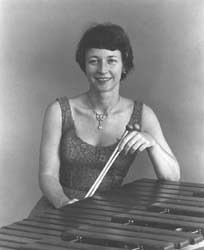Genres classical Role Music performer Name Vida Chenoweth | Years active 1956-1961 | |
 | ||
Occupation(s) marimbistethnomusicologistlinguist Books Melodic Perception and Analysis: A Manual on Ethnic Melody Similar People Clair Omar Musser, Leigh Howard Stevens, Gordon Stout, Nancy Zeltsman, Paul Creston | ||
Education Northwestern University | ||
Vida Chenoweth (born 1929 in Enid, Oklahoma) was the first professional solo classical marimbist, an ethnomusicologist and a linguist.
Contents
Credited with being the first to perform polyphonic music on the marimba and for doing for the marimba what Pablo Casals did for the cello and Andrés Segovia did for the guitar, she made her solo debut in Chicago in 1956, followed by a successful recital in New York. She subsequently gave concerts all over the world.
She is the only concert marimbist who has appeared as guest soloist in Carnegie Hall with a major orchestra besides Ruth Stuber.
She was inducted into the Oklahoma Hall of Fame in 1985 and in 1994 into the Percussive Arts Society Hall of Fame.
Early life
Chenoweth's family owned a music store in Enid, Oklahoma and she was encouraged by her older brother to take up classical marimba.
The first instrument Chenoweth attempted was the piano but had to stop due to a broken index finger.
Sydney David, a local music teacher, gave her initial instruction on the marimba in 1941. While in high school in 1948, she studied under Clair Omar Musser at Northwestern University and was a member of his marimba orchestra, which performed in Chicago in 1948.
Chenoweth also studied composition and wrote pieces for marimba. She attended William Woods College in Missouri, transferring to Northwestern for her final two years of study and emerged with a double degree in music criticism and marimba performance. For graduate school, Chenoweth attended the American Conservatory in Chicago from 1952 to 1953, where she studied pedagogy of music theory, and canon and fugue with Stella Roberts, a pupil of Nadia Boulanger, and earned a double degree in music theory and percussion.
Music career
Chenoweth made her solo debut in Chicago in 1956, followed by a successful recital in New York and numerous other concerts around the world. In 1959 she premiered the Concerto for Marimba composed for her by Robert Kurka, and in 1961, she performed Paul Creston's Concertino for Marimba, both with the Orchestra of America conducted by Richard Korn. By 1962 all but four works in the marimba repertoire had been composed for her.
She was inducted into the Percussive Arts Society Hall of Fame in 1994.
As linguist and ethnomusicologist
In 1961 she nearly lost the fingers of her right hand in a gas oven explosion which left her hand severely burned. Unable to regain complete freedom of movement, she turned her attention toward linguistics and ethnomusicology.
She went to the Territory of New Guinea and served for thirteen years with Wycliffe Bible Translators as a linguist and Bible translator. There, with colleague Darlene Bee, she lived with the Usarufa tribe and learned their unwritten language. After Dr. Bee’s death, she completed a translation of the New Testament in Usarufa. Meanwhile, she studied the music of the Usarufas and many other tribes and became internationally known as a scholar who pioneered a new method of ethnic music analysis. She authored eleven books, including her textbooks Melodic Perception and Analysis and The Usarufas and Their Music, and numerous articles on the validity of oral music traditions throughout the world. She then developed a program in ethnomusicology for the Wheaton College Conservatory of Music based on her own theory of analyzing the music of unwritten music traditions. She has since retired as International Consultant for Wycliffe and as Professor of Ethnomusicology at Wheaton College and has archived her nearly 1000 field tapes of world music in the Library of Congress.
In 1974 she earned a Ph.D. in ethnomusicology at the University of Auckland, New Zealand. She is included in seven different Who’s Who lists and is named as one of the two thousand outstanding musicians of the twentieth century.
In 1990, Chenoweth was interviewed by the Chicago Tribune while a professor at the Conservatory of Music, which housed more than 700 tapes she had recorded.
